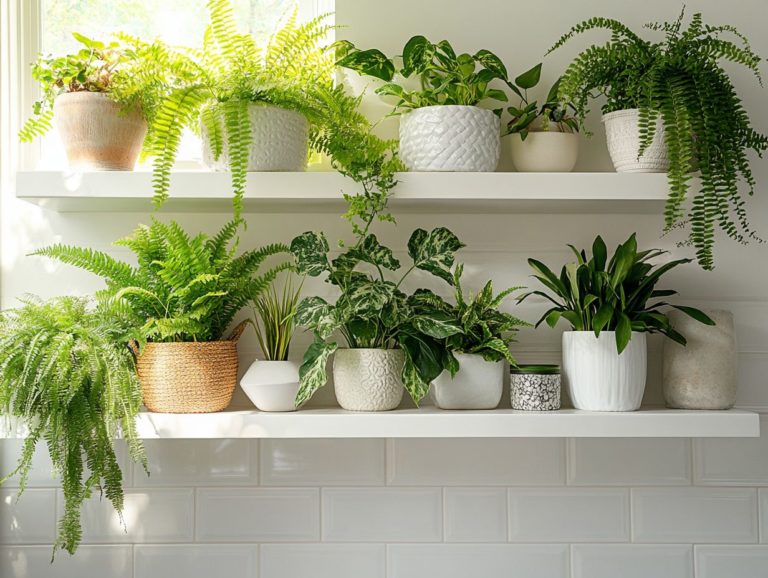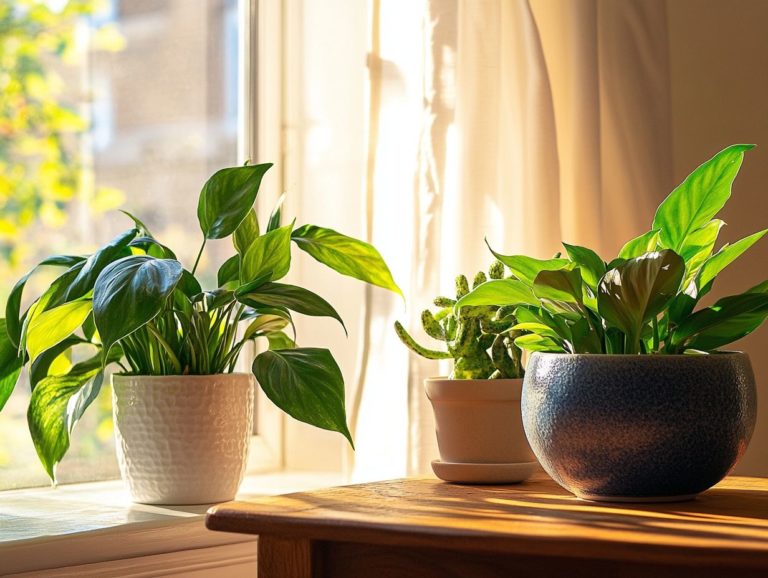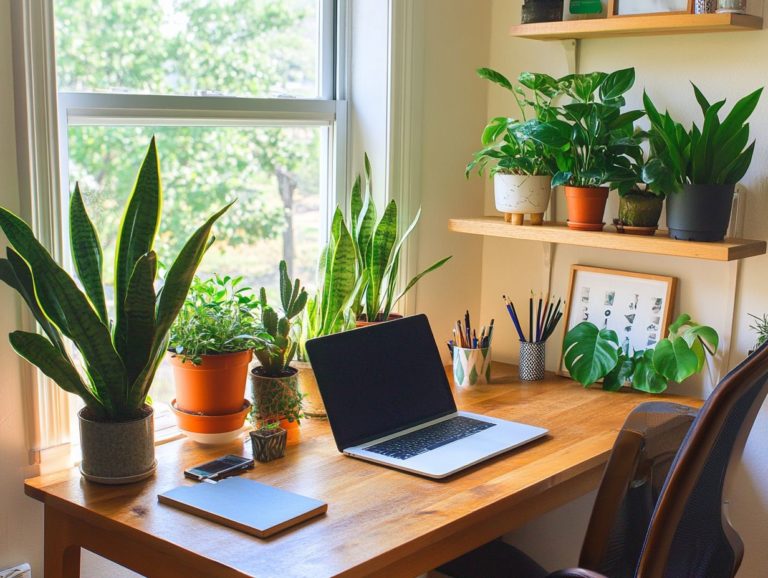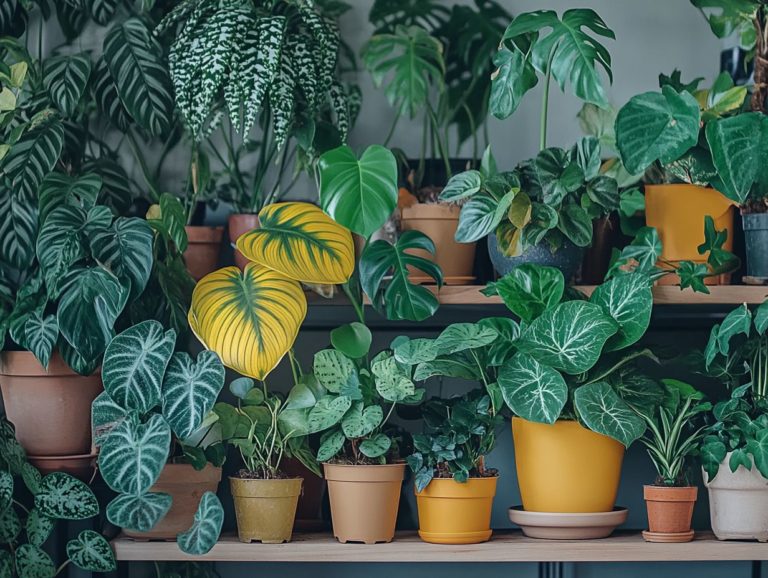How to Propagate Common Indoor Plants?
Plant propagation offers a thrilling opportunity to expand your indoor garden and enhance your houseplant care without straining your wallet.
As you consider multiplying your favorite houseplants or exploring new varieties, grasping the different propagation methods can truly elevate your gardening experience. This guide delves into essential techniques such as seed propagation, cuttings, division, air layering, and other methods.
You ll discover how to select the best plants for propagation, along with vital tips for success and common pitfalls to steer clear of. Prepare to nurture your green thumb and apply these growing tips to watch your indoor oasis flourish!
Contents
- Key Takeaways:
- Methods of Propagating Indoor Plants
- Choosing the Right Plants to Propagate
- Tips for Successful Propagation
- Common Mistakes to Avoid
- Frequently Asked Questions
- Can all common indoor plants be propagated?
- What is the best time of year to propagate indoor plants?
- How do I take stem cuttings for propagation?
- Can I propagate indoor plants in water?
- How long does it take for propagated plants to root?
- What are the key factors for successful propagation of indoor plants?
Key Takeaways:
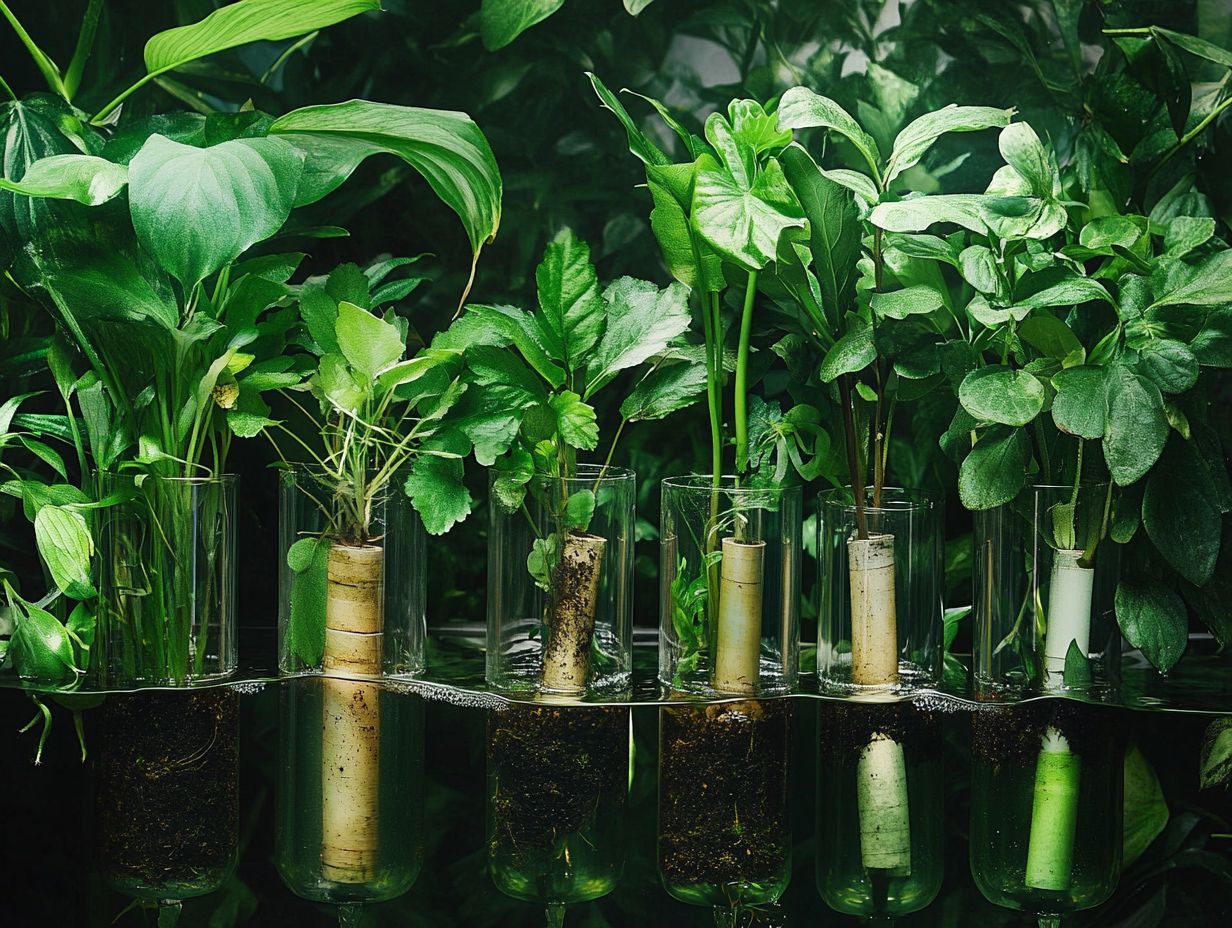
- Plant propagation is the process of creating new plants from existing ones.
- There are various methods of propagating indoor plants such as seed, cutting, division, and layering.
- To successfully propagate your houseplants, choose the right plants, follow essential steps, and avoid common mistakes in plant care.
What is Plant Propagation?
Plant propagation is your gateway to growing new plants from existing ones. It s an essential aspect of gardening that gives you the power to expand your houseplant collection or rejuvenate aging plants while ensuring their health and vitality.
You can explore various methods of propagation, such as seed germination, stem cuttings, leaf cuttings, and even advanced techniques like how to propagate succulents successfully. Each method offers unique environmental requirements and benefits for your indoor plants and container gardening.
Take, for example, the water method for stem cuttings. This approach is quite popular among gardeners, as it allows you to easily monitor root development. Enhancing your cuttings with a rooting hormone, a substance that helps plants grow roots faster, can significantly boost their success rate.
The soil method offers an alternative where cuttings are placed directly in the growth medium, often resulting in robust, thriving plants. By understanding these techniques, you not only maximize plant variety but also cultivate a deeper connection with nature, transforming gardening into a truly rewarding hobby.
Engaging in plant propagation can lead you to a flourishing green space, all while instilling a profound sense of accomplishment.
Methods of Propagating Indoor Plants
When successfully propagating indoor plants, you have a range of methods to choose from. Each method is tailored to the specific type of plant and your desired outcome.
It’s essential for you, as a gardening enthusiast or expert, to grasp the nuances of each technique to ensure optimal results.
Seed Propagation
Seed propagation serves as a cornerstone technique for growing new plants. You begin by sowing seeds in a suitable potting mix that meets their germination needs think moisture, temperature, and light exposure.
To set yourself up for success, selecting high-quality seeds is paramount. Preparing them through soaking or scarifying can significantly boost your germination rates. Once you ve planted the seeds, maintaining optimal soil conditions is a must.
A well-draining potting mix enriched with houseplant fertilizer can provide essential nutrients that support vigorous growth. Keep a close eye on moisture levels; seeds thrive in consistent dampness but do not like being waterlogged.
Light requirements will vary by species, so thoughtful placement near the right light sources is crucial. By regularly monitoring these conditions, you ll pave the way for healthy germination and flourishing plants.
Ready to dive into plant propagation? Let s get started!
Cutting Propagation
Ready to grow your plant collection? Cutting propagation is a fun and effective way to cultivate new plants. This favored technique among gardeners allows you to use stem or leaf cuttings to grow new plants. By enhancing this process with rooting hormone, you can expedite root development, setting the stage for vibrant growth.
If you’re looking to expand your plant collection, grasping the distinctions between these two cutting methods is vital. Stem cuttings involve taking a portion of the stem with nodes—nodes are the points on a stem where leaves grow—which typically root more swiftly and suit a variety of species, including succulents and shrubs. If you’re interested in a specific plant, learning how to propagate rubber plants can also be beneficial. On the other hand, leaf cuttings consist of a single leaf or a segment, proving especially effective for certain houseplants.
Using propagation vases helps maintain moisture levels. Rooting powder can significantly increase your success rate. It’s crucial to keep humidity high; regularly misting the cuttings or covering them with a plastic bag will help retain moisture, creating a nurturing environment for root formation. For more information, consider propagating indoor plants without soil.
Division Propagation
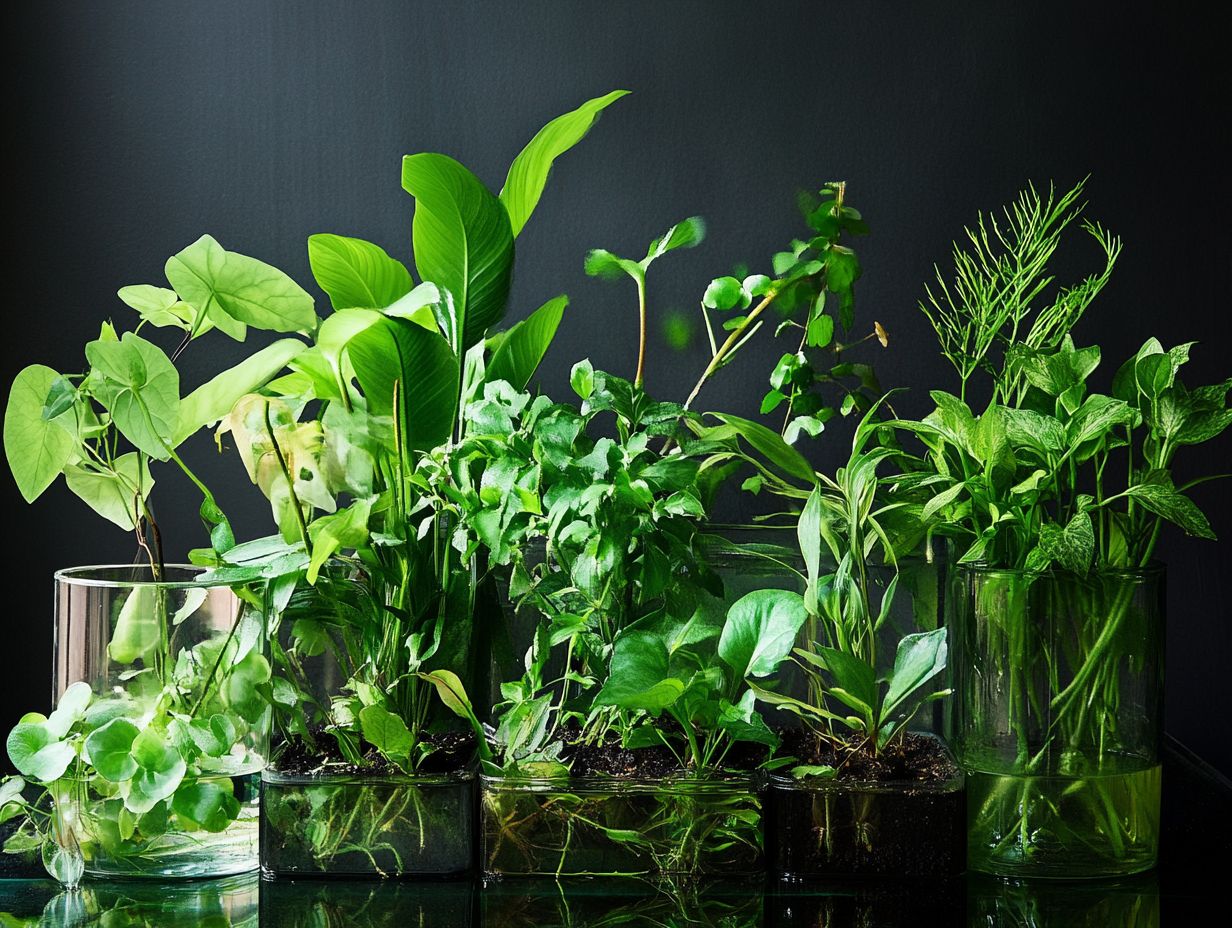
Division propagation is a fantastic way for you to reproduce robust plants by separating a single parent plant into multiple sections. This method guarantees each new plant has healthy roots and is ready to thrive.
This technique shines especially for perennial species that tend to form clumps. The optimal time for division usually arrives in early spring or fall, when the plants aren’t stressed by extreme temperatures.
To kick off the process, you should carefully dig around the root system to avoid damage. Gently separate the sections, ensuring that each one has healthy roots attached.
After replanting the divisions, enrich the soil with compost to promote new growth and guarantee that the individual plants receive plenty of moisture and the right light. Regularly monitoring and caring for them will help these new additions establish themselves and flourish in their new homes.
Layering Propagation
Layering propagation is a technique where you bend a stem of the parent plant down to the ground and cover it with soil, encouraging root formation. It s a favorite among gardeners, especially when tackling more finicky houseplants like the Monstera or Dracaena.
You have several methods at your disposal for layering propagation, with air layering and ground layering standing out as two popular options.
In air layering, you wound a section of the stem, wrap it in sphagnum moss, a type of moisture-retaining plant material, and cover it with plastic to keep the moisture in. This method allows roots to develop while still attached to the parent plant, similar to the top methods for indoor plant propagation.
On the flip side, ground layering entails bearing a portion of the stem while it remains connected to the original plant. This approach not only promotes healthy root growth but also helps ensure the overall vigor of the plant, allowing your specific houseplants to thrive even when indoor conditions like humidity are less than stable.
Choosing the Right Plants to Propagate
Choosing the right plants for propagation is essential for successfully expanding your houseplant collection. Some species are inherently more amenable to propagation techniques, making it vital for you to make informed selections that enhance your gardening experience.
Factors to Consider
When selecting plants for propagation, you should consider several key factors, particularly their environmental needs like moisture, humidity, and light conditions. These elements are essential for promoting plant health and ensuring that your propagation efforts are successful.
Beyond moisture and humidity, grasping the ideal temperature range is critical; many plants thrive best in a controlled environment that mirrors their natural habitat. Light exposure is equally vital; while some species bask happily in bright, direct sunlight, others prefer the gentler touch of indirect light to prevent leaf scorch. Additionally, understanding how to propagate indoor ferns can help ensure a thriving indoor garden.
By attentively monitoring these elements, you significantly enhance the likelihood of healthy growth in your propagated plants. For more personalized guidance, tapping into horticultural extension resources can offer specific advice and tips tailored to your chosen species, like aloe or gloxinia. Additionally, learning how to propagate your favorite houseplants will give you the best shot at success in your gardening pursuits.
Tips for Successful Propagation
To propagate houseplants successfully, pay close attention to details. This includes creating best growing conditions, mastering proper cutting techniques, and selecting good soil mix that effectively supports root development for your new plants.
Essential Steps and Techniques
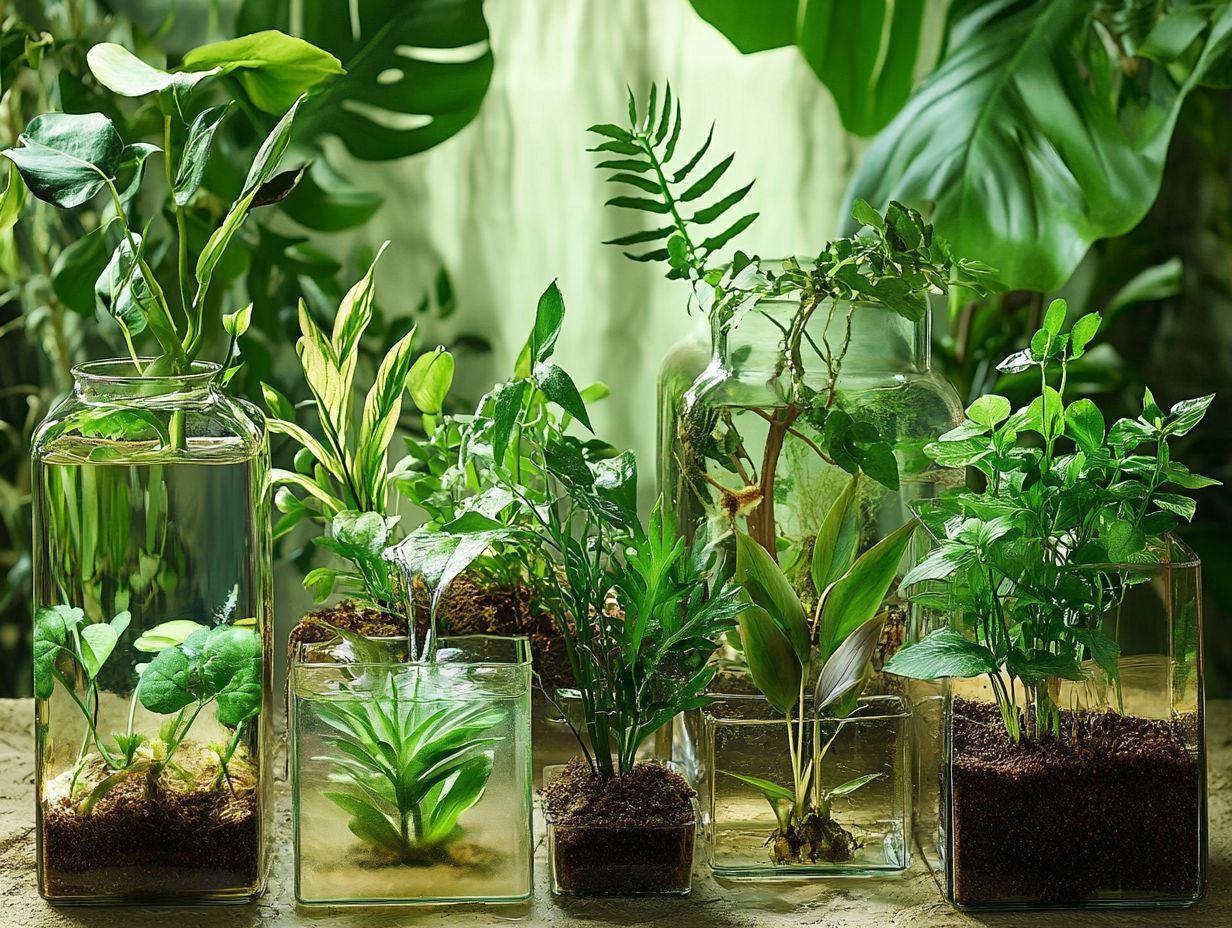
Follow these key steps to ensure your success: prepare the cutting, choose the right soil mix, and maintain optimal growing conditions.
Start with healthy parent plants. When taking a cutting, ensure it includes a few leaves and nodes this increases the likelihood of thriving. For detailed steps, check out this guide on how to propagate spider plants. Once you’ve made the cut, using rooting powder can significantly enhance the propagation process; this magical powder contains hormones that promote robust root development.
After applying the powder, it’s crucial to place the cuttings in a well-draining medium like peat or perlite to prevent any risk of rotting and ensure adequate moisture. Creating a greenhouse-like atmosphere filled with humidity and warmth will encourage rooting, vital for propagating houseplants. For more tips, consider learning about the best time to propagate your indoor plants. Regularly check moisture levels and provide indirect light while avoiding direct light to support healthy growth and elevate your chances of successful propagation.
Common Mistakes to Avoid
Avoiding common mistakes in plant propagation is crucial for ensuring the health and vitality of your new plants. Missteps in this delicate process can result in inadequate root development or, in unfortunate cases, the death of the plant.
By paying attention to details, you set the stage for thriving growth and flourishing greenery.
Preventative Measures and Troubleshooting
Implementing preventative measures in houseplant care significantly reduces the likelihood of common issues. Having troubleshooting strategies at your fingertips allows you to tackle challenges as they arise.
Understanding the specific needs of your plants is vital for their success! For example, tropical species like ferns and philodendrons thrive in environments with higher humidity levels, so monitoring moisture (with a hygrometer, a tool to measure moisture) becomes essential. On the flip side, succulents prefer drier conditions, so adjusting humidity for these plants can prevent rot.
Light exposure is another key factor. While snake plants enjoy indirect light, seedlings often thrive under grow lights to ensure they receive adequate brightness. Additionally, if you’re interested in expanding your plant collection, learning how to propagate monstera plants can be a rewarding endeavor. By keeping a vigilant eye on these elements and making necessary adjustments, you can create an ideal growing environment tailored to each plant’s unique needs.
Final Thoughts and Recommendations
Successful plant propagation combines knowledge with hands-on experience. Dive into this rewarding journey today! By selecting the right species and employing proper techniques, you not only elevate your gardening skills but also ensure that each new plant thrives in its environment.
This ongoing journey presents endless opportunities for creativity and exploration, allowing you to experiment with various propagation methods such as stem cuttings, leaf cuttings, or how to propagate herbs indoors by seed germination.
Each technique offers its own unique rewards and challenges, providing invaluable lessons along the way. As you develop your gardening expertise, embracing these different approaches will undoubtedly lead to remarkable results and a deeper connection with the vibrant world of plants.
Frequently Asked Questions
Can all common indoor plants be propagated?
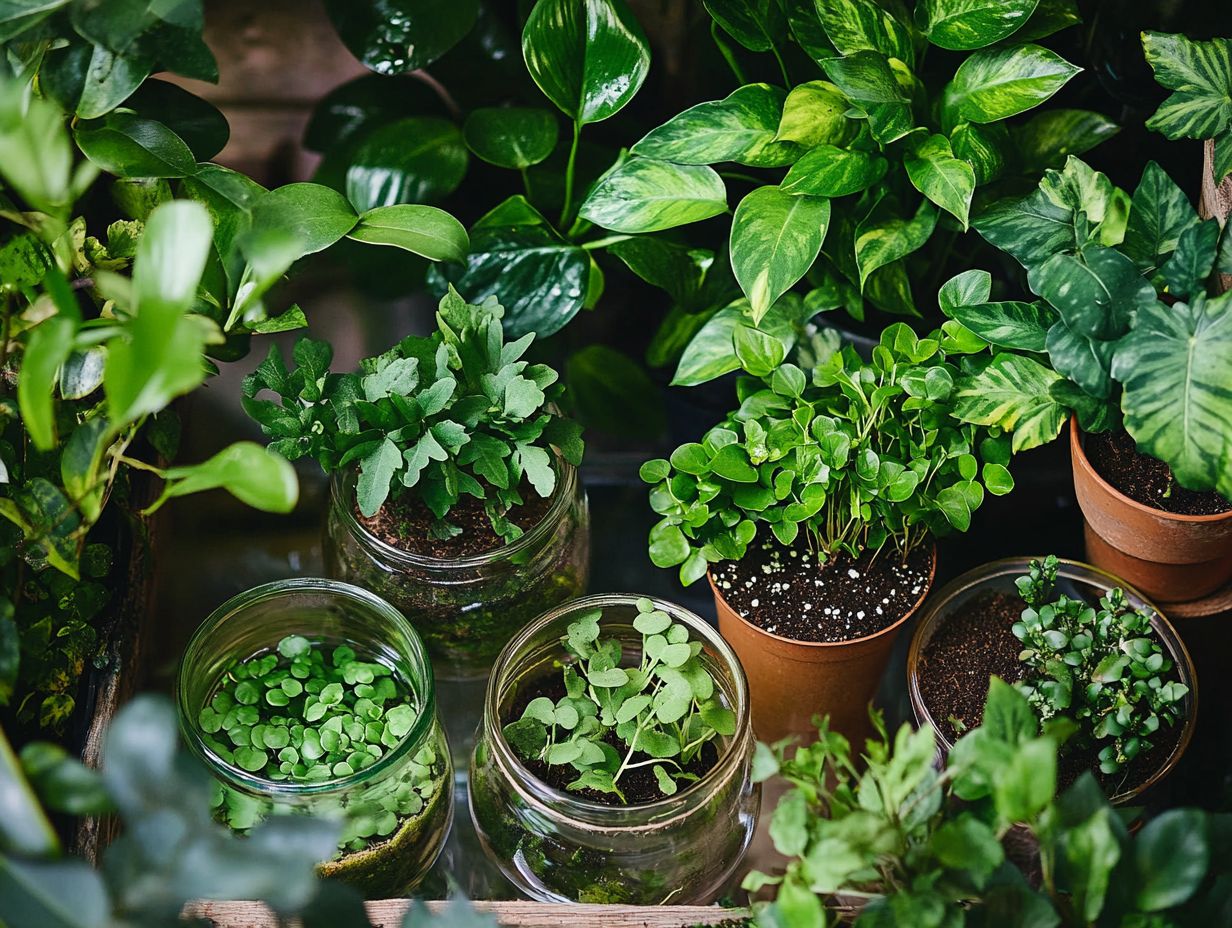
Yes, most common indoor plants can be easily propagated through various propagation methods such as stem cuttings, leaf cuttings, division, and air layering.
What is the best time of year to propagate indoor plants?
The best time to propagate indoor plants is in spring and summer. During these months, your plants are growing actively, which increases the chance of successful rooting.
How do I take stem cuttings for propagation?
To take stem cuttings, use clean, sharp scissors or gardening shears. Cut a 4-6 inch section of the stem just below the part where the leaf meets the stem, called a node.
Remove the lower leaves and place the cutting in water or damp potting mix to encourage it to root.
Can I propagate indoor plants in water?
Yes! Many indoor plants can be propagated in water. Just change the water every few days and move the rooted cutting to soil once it establishes a good root system.
How long does it take for propagated plants to root?
The time for a propagated plant to root varies. Some stem cuttings can root in just 2-3 weeks, while others might take a few months.
What are the key factors for successful propagation of indoor plants?
Key factors for successful propagation include using healthy, disease-free plant material. Ensure proper lighting, temperature, a well-draining potting mix, and consistent moisture levels.


